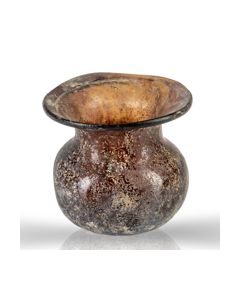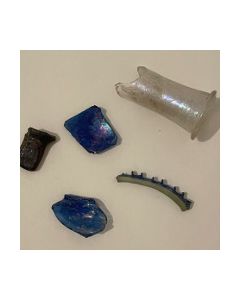Search results for: 'glas'
-
 Glass bottle with nub decoration
Glass bottle with nub decorationThe pear-shaped glass comes from the late Roman or early Byzantine period. Presumably from the Eastern Roman province of Palaestina.
Price: on request Late Roman glass flask
Late Roman glass flaskFlat bottle with double handle from the Eastern Mediterranean. Made between the 3rd and 6th century.
Price: on request Roman glass bracelet with spiral decoration
Roman glass bracelet with spiral decorationThe 4th century bangle is decorated with spiraling grooves on the outside. Made in the Eastern Mediterranean.
Price: on request Roman glass bottle with handle
Roman glass bottle with handleThe cylindrical vessel has a nice iridescent patina. Made between 50 and 200 AD on the Black Sea coast or in the Near East.
Price: on request Small Roman glass bowl
Small Roman glass bowlSmall bowl made of colourless glass, from the Roman Imperial period. The shape imitates metal vessels.
Price: on request Roman glass bracelet with spiral decoration
Roman glass bracelet with spiral decorationThe 4th century bangle is decorated with white spiraling glass inlay. Made in the Eastern Mediterranean.
Price: on request Roman glass beaker
Roman glass beakerRare cup made of almost colourless glass. A 4th century product from the eastern Mediterranean.
Price: on request Roman jug made of aubergine glass
Roman jug made of aubergine glassBeautiful glass with a violet colour. From the Roman Imperial period.
Price: on request Glass bead with polychrome decoration
Glass bead with polychrome decorationLarge bead made of opaque dark blue glass decorated with yellow lines and light blue eyes.
Price: on request Roman blue glass bowl
Roman blue glass bowlThe small storage vessel impresses with its beautiful cobalt blue colour. It was made in the 1st century, probably in Italy.
Price: on request Roman glass bowl
Roman glass bowlThe nice and small bowl is made of thick-walled glass. Possibly an Eastern Mediterranean made vessel.
Price: on request Roman globular glass bottle
Roman globular glass bottleBeautifully decorated with bands of incised decorative grooves. Spherical body and funnel-shaped neck.
Price: on request Roman glass jug with handle
Roman glass jug with handleA fine glass vessel from the 1st to 2nd century. Made in the eastern Mediterranean.
Price: on request Roman glass bowl
Roman glass bowlSmall bowl made of pale turquoise glass, from the Roman Imperial period. From the Heckmann collection.
Price: on request Byzantine glass pendant from Judaea
Byzantine glass pendant from JudaeaThe pendant with a lion and crescent motif was worn as a lucky charm or protective amulet. Made in the early Byzantine period in a glass workshop in Judaea.
Price: on request Roman glass inkwell
Roman glass inkwellLow vessel of cylindrical shape. The stylus was dipped into the ancient inkwell and wiped off at the edge. Beautiful, rich green glass.
Price: on request Roman glass pitcher
Roman glass pitcherFine and beautifully decorated glass pitcher from Roman Palestine, probably from an ancient workshop in what is now Jalamah. Around 500 AD.
Price: on request Byzantine glass pendant from Judaea
Byzantine glass pendant from JudaeaThe pendant with a cock and lion motif was worn as a lucky charm or protective amulet. Made in the early Byzantine period in a glass workshop in Judaea.
Price: on request Roman glass bottle
Roman glass bottleThe small glass vessel with a spherical body shows beautiful violet reflections and violet-brown transmissions. From the third century.
Price: on request Roman glass pitcher
Roman glass pitcherTurquoise glass jug from the late Roman Imperial period. From the Heckmann collection.
Price: on request Byzantine glass pendant from Judaea
Byzantine glass pendant from JudaeaThe pendant shows Romulus and Remus being suckled by a she-wolf. It was worn as a lucky charm or protective amulet. Made in the early Byzantine period in a glass workshop in Judaea.
Price: on request Byzantine glass pendant from Judaea
Byzantine glass pendant from JudaeaThe pendant with two portrait busts was worn as a lucky charm or protective amulet. Made in the early Byzantine period in a glass workshop in Judaea.
Price: on request Ancient glass fragments
Ancient glass fragmentsRoman glass shards from the 1st to 4th centuries. Professor Manegold Collection.
Price: on request Dark Roman glass paste with white band
Dark Roman glass paste with white bandThe Roman ring insert is in excellent condition. The small-format motif is not clearly identifiable, but it may show a head.
Price: on request Roman gold pendant with glass paste
Roman gold pendant with glass pasteThe piece of jewellery could be a big earring or the central piece of a necklace. Dating to Late Roman Imperial times.
Price: on request Necklace of Egyptian mosaic glass beads
Necklace of Egyptian mosaic glass beadsModernly threaded necklace of ancient beads made of beautiful mosaic glass and sheet gold. The mosaic originated in a workshop in Roman Egypt. Ex Christie's.
Price: on request Roman discus fibula with color glass paste
Roman discus fibula with color glass pasteSpannende Fibel mit Sterndekor und Glaspaste. Eine Weiterentwicklung keltischen Kunsthandwerks in der Zeit römischer Herrschaft. Gut dokumentierter Typ aus dem 2. Jh. v. Chr. mit Verbreitung in weiten Teilen Europas.
Price: on request Römisches Glasgefäß
Römisches GlasgefäßVollständig, jedoch an der Lippe in mehrere Teile zerbrochen. Aus der deutschen Privatsammlung Dr. Brünning, die in den 1930er und 1940er Jahren entstand.
Price: on request Glasierte persische Öllampe
Glasierte persische ÖllampeLanggezogene Schnauze, runder Körper, Henkel als Lilienblatt geformt mit Dekor. Restauriert.
Price: on request Glasierte persische Öllampe
Glasierte persische ÖllampeMuseumswürdig erhalten. Langgezogene Schnauze, runder Körper mit Kanneluren, Henkel als Lilienblatt geformt mit Dekor.
Price: on request Große römische Flasche für Parfüm, Glas, Syria/Palaestina
Große römische Flasche für Parfüm, Glas, Syria/Palaestina2. bis 3. Jhd. n.Chr., klassische antike Glasware, perfekt Erhalten, sehr farbenfrohe Patina. 8,8cm hoch.
Price: on request Römische Öllampe mit grüner Glasur
Römische Öllampe mit grüner GlasurRömische Provinzen Pannonia, 4. Jh. n.Chr., Spätantike, 82mm lang. Perfekt erhaltenes Exemplar.
Price: on request Große glasierte persische Öllampe
Große glasierte persische ÖllampeMuseal erhalten. Langgezogene Schnauze, runder Körper, Henkel als Lilienblatt geformt.
Price: on request Spätrömische glasierte Lampe aus griechischer Provinz
Spätrömische glasierte Lampe aus griechischer ProvinzRoter Ton mit dunkelolivem Überzug, 3. - 4. Jh. , ausgezeichnet erhalten. Mit vollständig erhaltenem Henkel.
Price: on request Glasierte persische Öllampe mit Inschrift
Glasierte persische Öllampe mit InschriftMuseal erhalten. Langgezogene Schnauze, runder Körper mit Kanneluren, Henkel als Lilienblatt geformt mit Inschrift.
Price: on request Glasierte islamische Öllampe
Glasierte islamische ÖllampeMuseal erhalten. Langgezogene Schnauze, runder Körper, durch Steg und Henkel mit diskusförmigem Standfuß verbunden.
Price: on request

